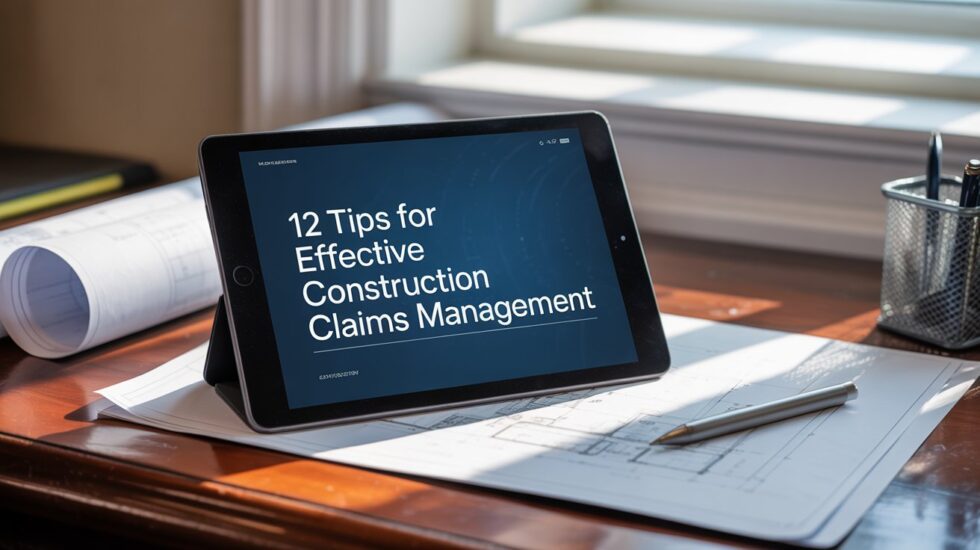
12 Tips for Effectıve Construction Claims Management
Construction projects involve numerous resources, including labourers, subcontractors, equipment, and materials. Lack of coordination and communication between the project team and stakeholders can lead to disputes both before and during the execution of the project.
Inadequate construction claims management, along with a lack of proactive actions, may result in defect claims, delay claims, and contractual issues throughout the project’s duration.
Common issues, such as unclear scope definition, poorly defined initial requirements, and lack of stakeholder involvement, are often the primary causes of disagreements between the parties.
What is Claims Management in Construction?
Claims management in construction is a crucial process for projects involving multiple resources and parties. One of the most effective techniques for managing claims and preventing disputes in the early phases of a project is addressing the root causes of potential issues before they arise.
For instance, clearly defined technical specifications for materials can help prevent disagreements over material quality during the execution phase. Principal stakeholders, each with their own interests and conflicting business requirements, inevitably encounter issues and disputes, as illustrated in the image below.
Claims Management in Construction – Root Cause Prevention Table
| Root Cause | Preventive Action | Stakeholders Involved | Disputes Avoided |
|---|---|---|---|
| Ambiguous technical specifications | Define clear, detailed specs before the project starts | Project Owner, Engineers, Contractors | Disputes over material quality or performance |
| Incomplete scope of work | Develop a comprehensive Scope of Work (SoW) document | Consultants, Contractors, Architects | Scope creep, cost overrun claims |
| Miscommunication between parties | Conduct regular alignment meetings & written records | All parties (Client, Consultant, Contractor) | Misunderstandings, timeline disputes |
| Unrealistic timelines | Use detailed scheduling and buffer time in planning | Project Manager, Client, Scheduler | Delay claims and penalty issues |
| Poor contract language | Use standard construction contracts (e.g., FIDIC) | Legal Advisors, Owners, Contractors | Ambiguities in rights, payments, and liabilities |
| Changes in design after execution begins | Implement a formal change management process | Designers, Client, Contractor | Extra cost and time claims |
Phases of a Construction Project
Typically, a construction project has four basic phases.
- Pre-Tender: Preparation of concept design and contract documentation.
- Contract Formulation: Preparation and submission of tenders and contract signing.
- Construction: Building & execution of the project
- Post Completion: Completion of the project.
Most of the disputes arise during the construction phase. However, the root causes of the disputes originate from the poorly managed tender and contract formulation phases. So that it is possible to prevent most of the claims by establishing a proper contact management system.
The construction phase makes disputes unavoidable because of its nature. Clients, stakeholders, project teams, and subcontractors often have particular requirements and expectations.
Therefore, during the construction phase, the role of the contract manager is critical in documenting all important events related to disputes. For example, if the process of land handover is completed, then all land-related information, dates, and agreements must be well documented.
Many people think that claims originate from contractors’ needs, and contractors often make claims against the client. However, claims may or may not originate from the client’s requirements.
12 Tips For Effective Construction Claims Management
As we discussed above, in a construction project, claim prevention actions can be taken effectively during the pre-tender and contract formulation phases.
Well-created contract documents and design files offer a great opportunity for construction claims prevention. Once the construction phase begins, claim prevention becomes difficult.
Although the impact of claims can be minimised by effective project and contract management, claims may arise from disputes.
In case of a claim occurrence, effective construction claims management must be done in order to avoid potential losses.
Construction Claims Management Process – Step-by-Step Table
| Step | Recommendation | Purpose / Objective |
|---|---|---|
| 1 | Review the claim file & legal basis | Validate the legal grounding of the contractor’s claim |
| 2 | Conduct a site investigation | Gather factual and environmental data to verify conditions |
| 3 | Analyse the contractor’s proof | Assess if the documentation is sufficient to support the claim |
| 4 | Review the bid breakdown | Check the original cost estimation for accuracy and justification |
| 5 | Match contract requirements | Ensure the submitted claim follows contractual guidelines |
| 6 | Study site reports & records | Understand facts, identify verifiable or questionable points |
| 7 | Compare current vs. claimed schedule | Identify discrepancies or justified changes in the timeline |
| 8 | Hold a meeting with the contractor | Clarify positions, validate facts through discussion |
| 9 | Conduct a productivity analysis | Compare claimed productivity vs. actual site performance |
| 10 | Calculate overhead from daily reports | Determine actual vs. claimed overhead costs |
| 11 | Evaluate claim strengths & weaknesses | Prepare for negotiation or dispute resolution |
| 12 | Prepare an action plan | Strategically manage the resolution process |
The Bottom Line
Claims management is the process of identifying and evaluating potential claims. Unlike other industries, construction disputes have their characteristics. Therefore, conflict resolution techniques differ from other industries.
The parties involved in any construction project may have conflicts even if they have the same goal. Effective claim analysis and prevention practices are essential for securing projects from damage.
اثر و رسوخ کے دعوے کے انتظام کے لئے 12 نکات
مؤثر تعمیراتی دعووں کے انتظام کے لئے 12 تجاویز تعمیراتی منصوبوں میں مزدوروں، ذیلی ٹھیکیداروں، سازوسامان اور مواد سمیت متعدد وسائل شامل ہیں. منصوبے کی ٹیم اور اسٹیک ہولڈرز کے درمیان ہم آہنگی اور مواصلات کی کمی منصوبے پر عمل درآمد سے پہلے اور اس کے دوران تنازعات کا باعث بن سکتی ہے۔ ناکافی تعمیراتی دعووں کے انتظام کے ساتھ ساتھ فعال اقدامات کی کمی کے نتیجے میں منصوبے کی مدت کے دوران نقائص کے دعوے، تاخیر کے دعوے اور معاہدے کے مسائل پیدا ہوسکتے ہیں۔
عام مسائل ، جیسے غیر واضح دائرہ کار کی تعریف ، ناقص طور پر بیان کردہ ابتدائی ضروریات ، اور اسٹیک ہولڈرز کی شمولیت کا فقدان ، اکثر فریقین کے مابین اختلافات کی بنیادی وجوہات ہیں۔ تعمیرات میں کلیمز مینجمنٹ کیا ہے؟ تعمیرات میں دعووں کا انتظام متعدد وسائل اور جماعتوں کو شامل کرنے والے منصوبوں کے لئے ایک اہم عمل ہے۔ کسی منصوبے کے ابتدائی مراحل میں دعووں کے انتظام اور تنازعات کی روک تھام کے لئے سب سے مؤثر تکنیک وں میں سے ایک ممکنہ مسائل کے پیدا ہونے سے پہلے ان کی بنیادی وجوہات کو حل کرنا ہے۔
ایک تعمیراتی منصوبے کے مراحل عام طور پر ، ایک تعمیراتی منصوبے میں چار بنیادی مراحل ہوتے ہیں۔ پری ٹینڈر: تصور ڈیزائن اور معاہدے کی دستاویزات کی تیاری. معاہدے کی تشکیل: ٹینڈروں کی تیاری اور جمع کرنا اور معاہدے پر دستخط کرنا۔ تعمیر: تکمیل کے بعد منصوبے کی تعمیر اور عملدرآمد: منصوبے کی تکمیل۔ زیادہ تر تنازعات تعمیراتی مرحلے کے دوران پیدا ہوتے ہیں۔
تاہم، تنازعات کی بنیادی وجوہات ناقص طریقے سے منظم ٹینڈر اور معاہدے کی تشکیل کے مراحل سے پیدا ہوتی ہیں. تاکہ ایک مناسب رابطے کے انتظام کا نظام قائم کرکے زیادہ تر دعووں کو روکنا ممکن ہو۔
تعمیراتی مرحلہ اپنی نوعیت کی وجہ سے تنازعات کو ناگزیر بنادیتا ہے۔ گاہکوں ، اسٹیک ہولڈرز ، پروجیکٹ ٹیموں ، اور ذیلی ٹھیکیداروں کی اکثر خاص ضروریات اور توقعات ہوتی ہیں۔ لہذا ، تعمیراتی مرحلے کے دوران ، تنازعات سے متعلق تمام اہم واقعات کو دستاویزی شکل دینے میں کنٹریکٹ منیجر کا کردار اہم ہے۔
مثال کے طور پر، اگر زمین کی حوالگی کا عمل مکمل ہو جاتا ہے، تو زمین سے متعلق تمام معلومات، تاریخوں اور معاہدوں کو اچھی طرح سے دستاویزی ہونا ضروری ہے. بہت سے لوگ سوچتے ہیں کہ دعوے ٹھیکیداروں کی ضروریات سے پیدا ہوتے ہیں ، اور ٹھیکیدار اکثر کلائنٹ کے خلاف دعوے کرتے ہیں۔
تاہم ، دعوے کلائنٹ کی ضروریات سے پیدا ہوسکتے ہیں یا نہیں ہوسکتے ہیں۔ مؤثر تعمیراتی دعووں کے انتظام کے لئے تجاویز جیسا کہ ہم نے اوپر ذکر کیا ہے ، تعمیراتی منصوبے میں ، دعوے کی روک تھام کے اقدامات پری ٹینڈر اور معاہدے کی تشکیل کے مراحل کے دوران مؤثر طریقے سے اٹھائے جاسکتے ہیں۔ اچھی طرح سے تیار کردہ معاہدے کی دستاویزات اور ڈیزائن فائلیں تعمیراتی دعووں کی روک تھام کے لئے ایک اچھا موقع پیش کرتی ہیں.
ایک بار جب تعمیراتی مرحلہ شروع ہوتا ہے تو ، دعوے کی روک تھام مشکل ہوجاتی ہے۔ اگرچہ دعووں کے اثرات کو مؤثر منصوبے اور معاہدے کے انتظام کے ذریعہ کم سے کم کیا جاسکتا ہے ، لیکن دعوے تنازعات سے پیدا ہوسکتے ہیں۔ دعوے کے وقوع پذیر ہونے کی صورت میں، ممکنہ نقصانات سے بچنے کے لئے مؤثر تعمیراتی دعووں کا انتظام کیا جانا چاہئے.
نچلے حصے کا انتظام انتظامیہ ممکنہ دعووں کی نشاندہی اور اس کا اندازہ کرنے کا عمل ہے۔ دیگر صنعتوں کے برعکس ، تعمیراتی تنازعات میں ان کی خصوصیات ہیں۔ لہذا ، تنازعات کے حل کی تکنیک دیگر صنعتوں سے مختلف ہیں۔ کسی بھی تعمیراتی منصوبے میں شامل فریقوں میں تنازعات ہوسکتے ہیں چاہے ان کا ایک ہی مقصد ہو۔ منصوبوں کو نقصان سے محفوظ رکھنے کے لئے مؤثر دعوے کا تجزیہ اور روک تھام کے طریق کار ضروری ہیں۔








